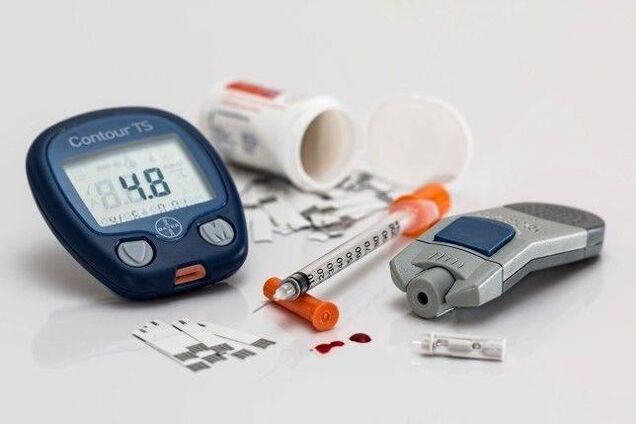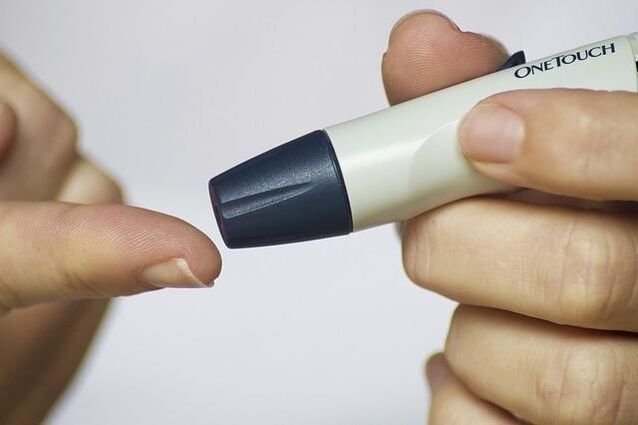
Diabetes mellitus is a serious endocrine disease with severe insulin deficiency. The disease is considered incurable and treatment with folk remedies at home only weakens the symptoms.
There are many reasons for the appearance of the disease. A viral disease, a genetic predisposition, medication or a difficult pregnancy can trigger an attack.
Types of diabetes
The disease, like bronchitis or cough, has obvious symptoms and signs. Depending on them, 5 types of diabetes are distinguished.
- 1 type. The immune system attacks the pancreas, which does not release insulin in the right amount, which is responsible for glucose metabolism. Traditionally, type 1 diabetes has been a problem for young people. Among cases of diabetes, the first type occupies one tenth.
- type 2. Human organs and tissues lose their sensitivity to insulin. It is worth noting that the pancreas produces this substance in normal amounts. The second type of disease affects 90% of diabetics.
- Gestational diabetes. Occurs exclusively in women during pregnancy. This type of diabetes mellitus differs from other types in that after the birth of a child it often disappears. Only 5 percent of expectant mothers experience it.
- secondary diabetes. A health condition in which various disorders lead to an increase in glucose level. This type is considered as a consequence of hormonal failure, medication, chronic pancreatitis or removal of the pancreas.
- paradiabetes. Appears when there are no health problems. For a long period, the patient's sugar is at the level of the maximum norm. It is caused by heredity, wrong lifestyle, malnutrition and obesity.
Diabetes of the first two types cannot be completely cured. However, with the help of diets, treatment and moderate exercise, people with this diagnosis live a long and normal life.
Symptoms of diabetes

The symptoms of the disease often do not appear immediately. As a result, the disease disappears for a long time, without betraying its presence.
In medicine there are times when the onset of diabetes comes as a surprise to a person. The patient goes to the doctor for advice on a certain disease and after passing the tests, learns about diabetes.
People often suffer from two types of diabetes, each with its own symptoms. Some common symptoms can be identified.
- thirst. One of the main harbingers of diabetes, regardless of type. However, other diseases also cause thirst, so doctors do not focus on this symptom when making a diagnosis.
- Frequent urination. The symptom is characteristic of both types of disease. Frequent, frequent urination signals a violation in the urinary system.
- Fatigue. Drowsiness along with chronic fatigue are symptoms that accompany all kinds of diseases, the list of which includes diabetes mellitus.
- Low temperature. Most often, in people suffering from an illness, the body temperature drops - below 36 degrees.
- Rapid weight loss with increased appetite. People who constantly want to eat and lose weight for no reason are advised to be vigilant and undergo an examination.
- Low tissue regeneration. With diabetes, even a small skin lesion heals for a long time. There are often ulcers and sores that cry.
- Visual impairment. Some diabetics complain that a white "veil" appears in front of their eyes and the image becomes blurred. But eyesight can get worse with age.
- Impaired circulation in the limbs. Manifested by tingling and numbness. Often, cramps appear in the calf muscles.
- Deterioration of power. Diabetic men often have erection problems. In women, the disease causes dryness of the genitals.
Remember, the level of severity of symptoms depends on the characteristics of the body. In one person the listed symptoms are pronounced, while in the other they are absent. The stage of the disease also affects the severity of the symptoms. With severe violations of insulin secretion, the symptoms are more pronounced.
Treatment of diabetes with folk remedies
Diabetes overwhelms a person when the pancreas fails to cope with its tasks and releases insulin in small amounts. This substance helps the body break down sugars. As a result, there is an excess secretion of sugar in the urine. And although doctors constantly analyze the passage of the disease, effective methods of treatment have not yet been established.
It is allowed to treat diabetes mellitus at home with folk remedies under the mandatory supervision of an endocrinologist. The main factor in therapy that affects the progression of the disease is diet.
Carbohydrates are excluded from the diet. If this is not possible, their consumption is reduced. Instead of regular sugar, the use of xylitol, sorbitol or starch-containing products is recommended.
The list of folk remedies used in the treatment of diabetes is represented by natural fruits, vegetables, medicinal plants and berries. Often, the individual components are used together, which enhances the healing effect.
- clover infusion. Combine one part clover grass with the same amount of boiling water and wait three hours. Drink the drug before meals for 0, 33 cups. Add flowers to enhance the effect.
- cranberry leaves. Pour a cup of boiling water over a tablespoon of dried leaves, wrap and wait 30 minutes for the liquid to be injected. After carefully straining the infusion, drink one cup three times a day.
- walnut leaves. Grind two dozen green walnut leaves, place in a saucepan, pour a glass of juice, simmer and simmer for 10 minutes. Take the medicine without any restrictions during the day.
- herbal collection. Mix twenty grams of cranberry leaves, birch buds, panties and nettles, add five grams of St. John's wort with ten grams of dandelion root, mix and chop. Pour four tablespoons of the mixture into a cup of boiling water from the kettle, wait a bit, filter and take 0. 33 cups three times a day.
- burdock roots. Eat with boiled or fried cheese. Some people use burdock root instead of potatoes and add them to soups and meatballs.
- Cranberry decoction. Boil a tablespoon of leaves together with the shoots on low heat, then cool slightly and drain. To be treated with this medicine take one tablespoon three times a day.
Since the disease is serious, start therapy immediately. The recipes I have shared will help.
What you can eat with diabetes

Continuing the topic of conversation, we will discuss what is allowed to eat with diabetes. According to doctors, food plays an important role in treating the disease, as the process of utilizing glucose, which enters the body with food, is disrupted.
A high level of a substance in the blood contributes to the development of complications and has a pathological effect on the body. At the same time, in diabetes, proper nutrition has a therapeutic effect.
Therapeutic nutrition focuses on the normalization of carbohydrate metabolism. This reduces the load on the pancreas. It is recommended to eat food often and regularly, distributing evenly or limiting carbohydrate intake. The diet should include protein foods along with low fat foods. The list of preferred food processing methods is represented by steam, cooking and baking.
I will introduce you to the foods that are recommended to eat with diabetes. Many foods are allowed to be consumed, you just need to track the calorie content and carbohydrate saturation.
List of foods allowed for diabetes
- Fish and meat. Only weak species. Doctors advise taking beef, chicken, rabbit, cod, perch and peak for cooking. It is allowed to eat canned seafood and fish in small quantities.
- Dairy products. Give preference to skim milk and kefir. Eggs are allowed. Eat two meals a day.
- Flour products from bran rye flour. You can also eat pasta in small quantities. Fiber-rich pasta is the best.
- Barley, buckwheat, oats and millet cereals. Make porridge or aromatic soup from cereals. It is better to refuse rice and oatmeal, as they raise blood sugar.
- Fiber-rich vegetables. Broccoli, beans, zucchini, cabbage, eggplant and radishes. Do not abuse beets and red potatoes. Steamed or roasted vegetables.
- Berries and fruits. Include sour varieties of apples, pears, currants and citrus fruits in your diet. Eliminate watermelons, melons, raisins, bananas, grapes and figs from your diet.
- Diet cakes. The composition should include sugar substitutes. It is allowed to use diet halva and honey.
- Pumpkin and sunflower seeds. These dry foods are rich in fiber, vitamins, trace elements and beneficial acids. Nuts are allowed, but the daily amount of peanuts or nuts should not exceed 50 grams.
- Drinks. Decoctions, teas, compotes, kisses and juices are considered extremely beneficial. Non-carbonated mineral water and alcohol, in which the sugar is not more than 5 percent is allowed. It is better not to drink coffee.
In addition, I will list some foods and spices that lower sugar. These are parsley, tomatoes, onions and zucchini, cucumbers, black currants and eggplants, turmeric, ginger and cinnamon.
How to prevent the development of diabetes?
Every person with diabetes knows that only a great deal of effort ensures a normal life. Otherwise, the disease dictates the rules. Prevention helps prevent the development of the disease and minimize the likelihood of complications.
The development of the first type of disease can not be prevented. There are activities focused on the second type.
Proper nutrition. This is the foundation of good health. Remember, being overweight along with obesity accelerates the onset of the disease, so make sure you eat properly.
Compliance with water balance. The human body is made up of seventy percent water, which helps digest food and remove decaying waste. In diabetes, fluids are involved in many processes.
Sports. People with diabetes are overweight. If you pay attention to sports, you can stop the development of the disease. Physical activity is an essential element of prevention.
Equally important in life is emotional mood and mood. Nerves contribute to the occurrence of diseases, so for preventive purposes, attend trainings, consult a doctor and fight depression.
It is forbidden to take medication without a doctor's prescription, otherwise the situation will worsen.
In the article, we reviewed the types of diabetes mellitus, identified the symptoms of the disease, considered home treatment, and figured out what to eat with it and how to act on prevention. Use the knowledge obtained at your discretion, but do not forget to consult a doctor. Good health!

























